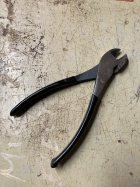RegionRat
Gold $$ Contributor
And since we have opened Pandora's Box... for the benefit of the less experienced....In a nutshell, this is not the tool to use if you are salvaging rounds due to others in the batch are suspect to have loose primer pockets. Use a pair of pliers and bend the bullet out of the brass by hand with no impact, salvage the powder and toss the rest of the mess.
We are not going to single out Mike for volunteering the story, but since his bolt face and hammer posts bring up a few important safety lessons... let's use the lessons learned to avoid issues. By telling his story, he may be keeping the next rookie from putting primers in blown pockets.
The point of this is discussion is to point out the deficiency in general advice to folks leaning on their own.
There really should not be an instance of needing to disassemble a round where the primer was put into a blown pocket. Cases are getting hard to come by without a doubt, but they are not worth risking gas leaks or collateral damage.
The first opportunity to scrap the brass, comes when the spent primer is removed from the case. In non-crimped cases, pockets that give up the spent primer with abnormally low force are a red flag. In crimped brass, the use of a gage is what keeps you out of trouble.
But, if by chance the rookie is handed used brass where the primers were already removed, what then?
It is still the loader's responsibility to inspect the brass, including the pockets. The primer installation force is a warning all by itself.
Let's say we are loading on different types of presses or using different priming tools with respect to keeping things safe.
On a progressive machine where we are potentially auto-loading or where there is a chance that there is not enough sensitivity to "feel" the problem, we introduce the concept of gages and inspection. When primer pockets are blown, they fail the gages and we do not proceed to load them.
On traditional single stage presses, the user has the responsibility to either gage pockets or learn to know when the "feel" is wrong, preferably both.
It is possible that Mike didn't realize he was getting into trouble when putting primers in blown brass. Not enough emphasis has been placed on the importance of the primer pocket to primer relationship.
With any hand priming tool, the user has more than enough warning if the primer just drops into the pocket such that it would just back off when the case is being tapped on a table, etc..
In general, when you take on loading, you also must take responsibility for the priming.
Being trained and taught by a mentor, means the mentor needs to warn the student of these risks. Best when they arrange a demonstration of a loose pocket versus one that meets the bare minimum dimensions.
Suppose someone like our OP has no mentor and is learning this on their own. As a community we have failed to put much importance on this point, but that is just my opinion.
My opinion is based on belonging to several clubs where the rookies have struggled with ammo and component shortages, and we are seeing a rash of blown primer pockets and I think there is a connection.
Being on their own, and the reluctance to scrap brass, combines with little warning in their training from the internet or YouTube and we get mistakes.
There is a question about what text books say about importance of investment in gages for primer pockets.
None of us were with Mike when he was leaning, and we don't know if there was much warning when he put primers in what would be called failed pockets. Only Mike can say if he should have even put another primer in the cases or not.
Once that line is crossed and a primer is put into a blown pocket, all bets are off on the impact hammer, as well as loading into any semi-auto context.
Glad the story about the hammer and his bolt face has a happy ending. Play it safe folks.
Last edited:















